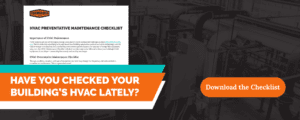COVID-19 can make it difficult to figure out what measures you should take as a facility manager to keep your occupants safe. One of those measures may include the installation of UV lighting within your building’s HVAC system. This article answers questions about UV Lights in HVAC.
- What Are UV Lighting Systems?
- Does UV Light Kill Viruses?
- Are UV Lights Effective Against COVID-19?
- What Types Of UV-C Light Are In HVAC Systems?
- What Are The Benefits Of UV-C Light In A Building’s HVAC System?
- Do You Need UV-C Lightning In Your Building’s HVAC System?
1. What are UV Lightning Systems?
UV Lights are in the news because of the pandemic, but the technology is over 100 years old. Shortwave radiation (UV-C) is emitted from these systems and is most effective at killing mold, bacteria, and viruses. When properly installed and maintained within an HVAC System, UV Lights increase the quality of air in buildings.
2. Does UV Light kill viruses?
In short, yes. The radiation found in broad-spectrum UV-C light kills viruses and bacteria. The lights are in restaurants, grocery stores, and hospitals to disinfect surfaces and equipment. Note: Direct exposure to UV-C light is extremely dangerous and should be installed by professionals.
3. Are UV Lights Effective Against COVID-19?
As of now, it is unclear, but the data shows it does work. According to the CDC UV-C lighting is one of the most promising decontamination methods. The effectiveness of sterilization, depends on the intensity and time of exposure to the UV-C light. For this reason, it is important to install the correct lightning and distribution system to maximize the sterilization effect of UV-C.
4. What are UV Lights in HVAC?
The most common applications are In-Duct Airstream Disinfection and Component Surface Sterilization. It is important to note that these two methods are very different and are dependent upon the desired outcome of the UV-C Light.
- In-Duct Airstream Disinfection: This method disinfects an air stream within a building, room, or ventilation system. The UV-C light and duct work are designed to expose the rapidly moving air to the most intense radiation for as long as possible. This is the most effective method for killing air-borne pathogens and fungi, because it destroys the micro-organisms as they enter the air stream.
- Component Surface Sterilization:This type of UV Treatment is designed to prevent and destroy microbial on air-coils and its neighboring surfaces. This type of UV System can be readily installed to HVAC Systems to help and maintain system cleanliness and the quality of indoor air. This method is least effective against bacteria that enters the air stream. It is most effective at killing bacteria and fungi that would grow within the coils and surface if the UV-C light was not there.

5. What Are the benefits of UV-C Light in building’s HVAC system?
In addition to killing bacteria, and viruses other benefits of UV light its ability to remove:
- Volatile Organic Compounds (VOCs). Examples include paint, carbon monoxide, and asbestos.
- Smells and other odors.
- Mold and other forms of fungi that can grow on the coil and neighboring surfaces.
6. Do you Need UV-C Lightning in your Building’s HVAC System?
The answer is, it depends. There is no “magic-bullet” when discussing protecting your building’s occupants from infectious diseases. But there are good steps to take and a UV-C Lighting System may be one of them. It is important to note, the CDC has not seen enough evidence to conclude that Covid-19 can live in a HVAC System. This is why we recommend you discuss the application, benefits, and costs of a system with your trusted HVAC Service Provider. You may find that there are other options that cost less and will have a better impact on your building’s air quality. Some of these examples are:
- Maintenance: Maintenance Programs do more than promote cleanliness in your building. It also increases energy efficiencies and reduces operational cost because your equipment breaks down less.
- Duct Seals: Sealing air ducts can prevent the infiltration of contaminants like mold, fungi, and VOCs.
- Air Balancing: Ensure all areas of your building are getting the correct amount of ventilation and conditioned air.
Need Help?
Do you have questions about UV Lights in HVAC? You can reach us at 1-800-237-3141 or email sales@rasmech.com for a free consultation.



